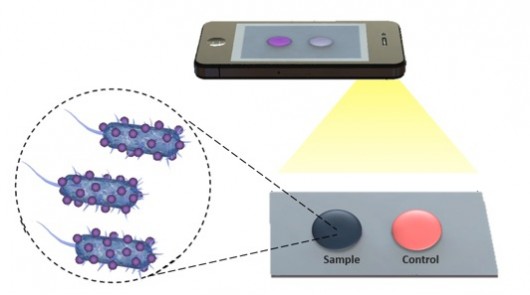
Researchers at Florida Atlantic University (FAU) have created a cheap and simple biosensing platform that is able to detect the presence of various types of harmful bacteria and viruses in a single drop of blood. When used in conjunction with a smartphone, the system offers the potential of diagnosing diseases in remote locations from anywhere in the world.
The way the system works is pretty similar to your standard PH test. Patients place a drop of blood from a finger prick or a bit of saliva on a small plastic film that has a piece of cellulose plastic on it. If the particular type of virus (eg. HIV) or bacteria (E-coli, Staphylococcus aureas, etc) the film has been designed to detect are present, it will turn blue.
Patients can then snap a shot of the film with their smartphone camera and send it off to a medical professional for analysis, wherever in the world they may be. While the technology could be useful in developed countries, it could be life-changing for developing countries that don’t have ready access to medical centers and equipment.
“There is a dire need for robust, portable, disposable and inexpensive biosensing platforms for clinical care, especially in developing countries with limited resources,” says Waseem Asghar, Ph.D., assistant professor of electrical engineering in the College of Engineering and Computer Science at FAU, and co-first author on the study.
Since the technology is inexpensive to make and the films can safely be disposed of after use by burning, long-term it could have a tremendous impact on the diagnosis and monitoring of infectious diseases worldwide, especially in low and middle-income countries.
The researchers behind the study see the idea eventually becoming part of people’s regular health monitoring routine, similar to how many track their daily activity each day with fitness trackers like FitBit. They also say the ease of manufacture and affordability means the technology could also find applications in drug development, food safety, environmental monitoring and veterinary medicine.
The team’s paper is published in Nature Scientific Reports.
Via GizMag







